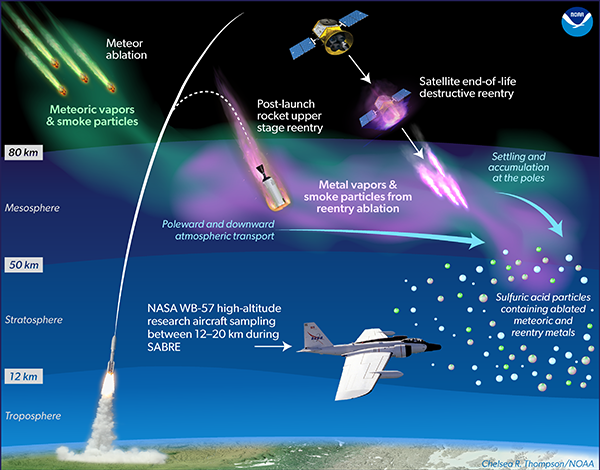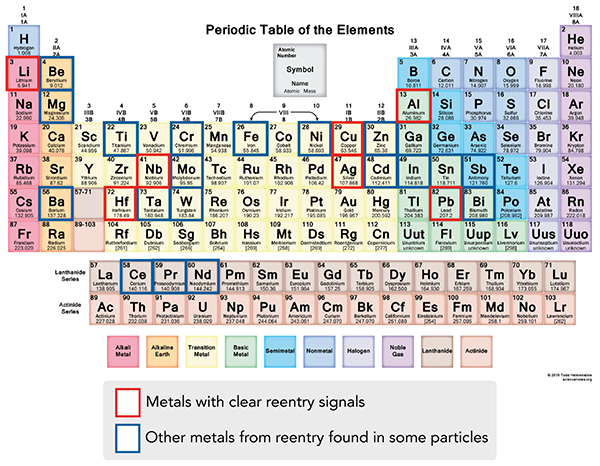A .gov website belongs to an official government organization in the United States.
A lock () or https:// means you've safely connected to the .gov website. Share sensitive information only on official, secure websites.
16 October 2023 NOAA scientists investigating the stratosphere have found that in addition to meteoric 'space dust,' the atmosphere more than seven miles above the surface is peppered with particles containing a variety of metals from satellites and spent rocket boosters vaporized by the intense heat of re-entry. The discovery is one of the initial findings from analysis of data collected by a high-altitude research plane over the Arctic during a NOAA CSL mission for Stratospheric Aerosol processes, Budget and Radiative Effects (SABRE). It's the agency's most ambitious and intensive effort to date to investigate aerosol particles in the stratosphere, a layer of the atmosphere that moderates Earth's climate and is home to the protective ozone layer. Using an extraordinarily sensitive instrument custom-built at NOAA in Boulder, Colorado, and mounted in the nose of a NASA WB-57 high-altitude research aircraft, scientists found aluminum and exotic metals embedded in about 10 percent of sulfuric acid particles, which comprise the large majority of particles in the stratosphere. They were also able to match the ratio of rare elements they measured to special alloys used in rockets and satellites, confirming their source as metal vaporized from spacecraft reentering Earth's atmosphere. The findings were published today in the Proceedings of the National Academy of Sciences. "Two of the most surprising elements we saw in these particles were niobium and hafnium," said CSL research chemist Daniel Murphy, who led a team including scientists from CIRES, Purdue, and the University of Leeds. "These are both rare elements that are not expected in the stratosphere. It was a mystery as to where these metals are coming from and how they're ending up there." The SABRE mission focused on aerosols, tiny particles that absorb and reflect the Sun's rays, shielding the Earth, and that in the right conditions serve as surfaces for ozone-destroying chemical reactions. This discovery by NOAA scientists represents the first time that stratospheric pollution has been unquestionably linked to reentry of space debris. Niobium and hafnium do not occur as free elements in nature, but are refined from mineral ores. They are used in semiconductors and superalloys. In addition to these two unusual elements, a significant number of particles contained copper, lithium and aluminum at concentrations far exceeding the abundance found in meteorics, or 'space dust.' "The combination of aluminum and copper, plus niobium and hafnium, which are used in heat-resistant, high-performance alloys, pointed us to the aerospace industry," Murphy said. All in all, scientists identified over 20 distinct elements from spacecraft and satellite reentry in particles sampled during SABRE, including silver, iron, lead, magnesium, titanium, beryllium, chromium, nickel, zinc, and lithium. NOAA scientists were able to precisely identify so many different metals thanks to a custom-built Particle Analysis by Laser Spectrometry (PALMS) instrument, which ingests and chemically analyzes individual particles in the air one by one as the aircraft is in flight. On the NASA WB-57, PALMS is installed into the nose cone of the aircraft with a large forward-facing air intake inlet. After entering the inlet, an aerosol particle passes through two detecting laser beams that measure its size and speed. A third high-powered laser is then precisely triggered to vaporize the particle. The electrically charged remnants are then swept into two identical mass spectrometers, one for positive ions and one for negative ions. The spectrometers determine the exact atomic mass and relative abundance of each element in the particle, generating a chemical "fingerprint" for each particle. Scientists are eager to understand how these particles of aerospace debris interact with other aerosols in the stratosphere because of anticipated increases in space traffic and their potential impact on the ozone layer. They also want to explore the impact of possible future proposals to seed the stratosphere with millions of tons of sulfur aerosols to slow the rate of global warming by reflecting sunlight back to space. While Murphy and his coauthors estimate that 10% of stratospheric sulfuric acid particles currently contain traces of metals from rockets and satellites, they say that could grow to 50% or more based on the number of satellites being launched into low-earth orbit, and efforts to eliminate space debris at end-of-life by directing it into the atmosphere to burn up. "There will be a lot of work to understand the implications of these novel metals in the stratosphere," Murphy said. As of October 4, Orbiting Now tracks and lists 8,697 satellites currently in orbit, 7,892 of which are in low Earth orbit and are destined to burn up on reentry. "At 10%, the current fraction of stratospheric aerosol with metal cores is not large." said co-author Martin Ross of The Aerospace Corporation. "But over 5,000 satellites have been launched in the past five years. Most of them will come back in the next five, and we need to know how that might further affect stratospheric aerosols."
Murphy, D.M., M. Abou-Ghanem, D.J. Cziczo, K.D. Froyd, J. Jacquot, M.J. Lawler, C. Maloney, J.M.C. Plane, M.N. Ross, G.P. Schill, and X. Shen, Metals from spacecraft reentry in stratospheric aerosol particles, Proceedings of the National Academy of Sciences, doi:10.1073/pnas.2313374120, 2023. Large increases in the number of low earth orbit satellites are projected in the coming decades [L. Schulz, K.-H. Glassmeier, Adv. Space Res. 67, 1002–1025 (2021)] with perhaps 50,000 additional satellites in orbit by 2030 [GAO, Large constellations of satellites: Mitigating environmental and other effects (2022)]. When spent rocket bodies and defunct satellites reenter the atmosphere, they produce metal vapors that condense into aerosol particles that descend into the stratosphere. So far, models of spacecraft reentry have focused on understanding the hazard presented by objects that survive to the surface rather than on the fate of the metals that vaporize. Here, we show that metals that vaporized during spacecraft reentries can be clearly measured in stratospheric sulfuric acid particles. Over 20 elements from reentry were detected and were present in ratios consistent with alloys used in spacecraft. The mass of lithium, aluminum, copper, and lead from the reentry of spacecraft was found to exceed the cosmic dust influx of those metals. About 10% of stratospheric sulfuric acid particles larger than 120 nm in diameter contain aluminum and other elements from spacecraft reentry. Planned increases in the number of low earth orbit satellites within the next few decades could cause up to half of stratospheric sulfuric acid particles to contain metals from reentry. The influence of this level of metallic content on the properties of stratospheric aerosol is unknown.2023 News & Events
NOAA scientists link exotic metal particles in the upper atmosphere to rockets, satellites
adapted from the story by NOAA Communications


Fingerprinting the chemical composition of particles
Pressing questions that need answers
Abstract